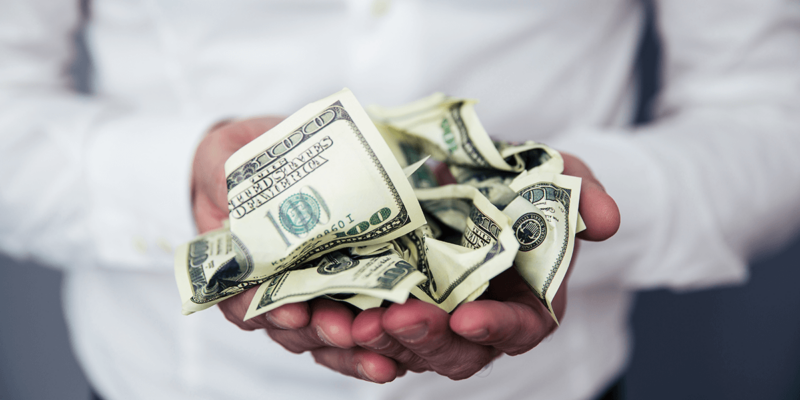Profit margins are key performance indicators (KPIs) for business executives. Determining a company’s liquidity is an essential part of providing the necessary information for decision-makers who must develop strategies to maintain profitability and potentially pay off debts. Calculating your business’s cash ratio is an efficient step toward keeping your company well-informed for the future. Learn more and check out our cash ratio calculator.
The Cash Ratio Explained
What is the cash ratio? This number is a reading of a business’s liquidity. A formula can be used to specify the ratio of an organization’s total cash to its liabilities. Higher-ups should pay attention to the cash ratio because it communicates how capable a company is of repaying short-term debts using cash and securities.
A high cash ratio often benefits companies by increasing the likelihood that creditors will allow a business to borrow money. The better your cash ratio, the more financing your company may be able to secure from a lender.
Different Types of Cash Flow Ratios
All cash flow ratios are used to determine the state of a company’s finances and different types can provide different insights. Consider the differences between quick and current cash ratios:
- Quick ratio: This ratio refers to how capable a business is of covering current liabilities using only its assets. The quick ratio is sometimes referred to as the acid-test ratio. When calculating the quick ratio, you should only include assets that could be converted to cash in 90 days or less.
- Current ratio: Determine the current ratio to measure a company’s capacity to cover short-term debts using short-term assets such as cash, merchandise or receivables.
About the Quick Ratio
The most significant difference between the quick and current ratios is that the acid-test ratio incorporates accounts receivable in the equation. This category can be understood as the money customers must pay back to your company in a given amount of time. The number and value of receivables you include in the calculation have the potential to make an impact based on the financial status of your company.
For example, your business may work with a client for years and issue receivables with a quick turnaround. This ongoing relationship creates a documented history of on-time payment collection — lowering the risks surrounding the receivables.
About the Current Ratio
The current ratio is also known as the working capital ratio. This measurement represents the value of the assets that your company can convert into cash in 12 months or less.
Businesses might bring marketable securities, inventory items or prepaid expenses into the calculation. These short-term assets will be evaluated against liabilities like accounts payable.
What Is a Good Cash Ratio?
A business’s cash ratio will change according to its industry and sector. Some industries depend on short-term debts and funding to keep operations moving. This scenario applies to manufacturing, distribution and technology fields where a high inventory turnover is required.
If you are unfamiliar with the cash ratio concept, the best approach is to strive for a ratio equal to or greater than one. A cash ratio close to one indicates that your business has sufficient funds and cash equivalents to cover all short-term debts.
If your company’s cash ratio is 0.5 or below, you should evaluate business plans and find potential areas for improvement. Ratios at 0.5 or less tell decision-makers that a business currently owes double its funds in short-term debt.
One Piece of the Financial Puzzle
Understand that a cash ratio measurement of 0.5 to one does not paint an entire picture of a company’s financial standing. Businesses rarely keep cash sitting around. Money on a balance sheet is likely missing investments made to create a more substantial return.
How to Find the Cash Ratio | Cash Ratio Calculator
The formula for finding your cash ratio is straightforward. Using this measurement allows you to evaluate your company’s cash or cash-equivalent holdings without considering accounts receivable. Find your organization’s cash ratio using the formula below:
- (Cash + Cash Equivalents) / Current Liabilities
Applying the cash ratio formula to your own business can be done in seconds. Consider these examples to see how the equation works in practice before using it to determine your company’s cash ratio.
Cash Ratio Example 1
We will map out a cash ratio example for Company A. For the 2021 calendar year, Company A held $700,000 in cash and equivalents. The business’s liabilities totaled $550,000 of short-term debt. Placing these numbers into the cash ratio formula, we can calculate the measurement for Company A:
- $700,000 / $550,000 = 1.27
With a ratio of 1.27, Company A is in a great financial position according to the cash ratio formula.
Cash Ratio Example 2
The next example will review data from Company B. The organization secured $650,000 between cash and equivalents. The liabilities for the business add up to $980,000 of short-term debt. Using the same formula, we can find the cash ratio for Company B:
- $650,000 / $980,000 = 0.66
While the cash ratio for Company B is above 0.5, there is still room for improvement.
Calculating the Quick Cash Ratio
The process for finding the quick cash ratio is slightly different from calculating the cash ratio. The quick cash ratio requires you to know the amount of cash and cash equivalents you have, as well as receivables.
The formula for the quick cash ratio of your business is:
- (Cash + Cash Equivalents + Receivables) / Current Liabilities
If you want to learn more about your cash flow and liquidity check out more details on Investopedia. If you’d like to improve your cash flow, contact Porter Capital and we can discuss debt free financing for your business.
How to Use the Quick Ratio Calculator
- Fill in total cash.
- Fill in marketable securities.
- Fill in accounts receivable amount.
- Fill current liabilities amount.
- Press Calculate.
Determining the Current Cash Ratio
Another formula is necessary to calculate the current cash ratio for your company. Filling out the current cash ratio formula requires decision-makers to gather the most information because the current cash ratio accounts for receivables and your inventory within the equation:
- (Cash + Cash Equivalents + Receivables + Inventory) / Current Liabilities
High vs. Low Cash Ratio Meaning
The numeral you see using the cash ratio formula explains how easy it will be for your business to pay back liabilities on an expedited timeline. When your company has a ratio of one, it carries the same amount of liabilities as it does cash. A ratio of one indicates that your business has exactly enough money to pay back debts — no more or less.
The cash ratio is an effective way to imagine how your business might respond under a worst-case scenario. For example, a company that is close to going out of business should review its current assets to convert them into cash if it means staying afloat and paying off debts.
Cash Ratio Calculations Above One
Your business has more cash and cash equivalents than liabilities when the cash ratio is higher than one. In this scenario, your business could pay off all short-term debts and still have money left over.
Cash Ratio Calculations Below One
A cash ratio calculation that is less than one translates to insufficient funds needed to eliminate existing short-term debts. There are scenarios where this ratio can be expected.
Companies that arrange long credit terms through suppliers, offer minimal credit options to clients or monitor inventory operations closely may see a cash ratio calculation of less than one.
How to Improve Your Cash Ratio
Once you calculate your company’s cash ratio, decision-makers can use that number to inform other decisions and employ methods to improve it.
1. Manage Your Overhead Expenses
Businesses cover rent payments, marketing expenses, equipment fees and other costs. Managing your overhead expenses down to only what you need leaves room for cash ratio improvements. Determine what costs are essential to continue operations and reduce spending where possible.
2. Analyze Your Debt Agreements
Businesses with short-term debt agreements may benefit from transitioning to long-term options. A long-term debt agreement reduces the cost of monthly payments and gives you the time you need to cover the sum.
Some decision-makers might transition from a long-term agreement to a short-term payment schedule to pay off debts faster, increasing the company’s cash ratio once debts are paid off.
3. Eliminate Unused Assets
Your team may have access to unneeded assets, including machines, vehicles and specialty equipment. Selling these unproductive assets is an effective way to grow cash balances. Take note of the unused assets you have in working condition to maximize your profits.
4. Edit Your Payment Schedule
You may be able to secure discounts from the vendors you work with by organizing pay-early agreements. Get the materials you need for success and potentially save thousands of dollars down the line.
5. Submit Your Invoices Quickly
Growing your cash ratio is achievable when you obtain prompt payments for goods and services. Working with an invoice factoring company allows you to receive payments much faster than waiting for clients to respond.
Porter Capital Can Help Improve Your Cash Flow
Growing your business requires a steady source of income. You can turn to Porter Capital for invoice factoring services when you need funds to keep your team moving. We’ll review your invoices from other businesses and advance your company cash upfront — within 24 hours for convenience.
Few invoice factoring companies can say they have 30 years of experience in the finance industry, but Porter Capital can. Whether your invoices are worth hundreds, thousands or millions of dollars, we have the knowledge and skills to assist you. To learn more about how we can help you, submit a contact form.




